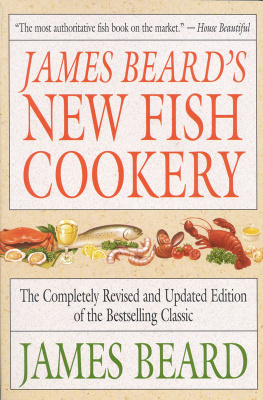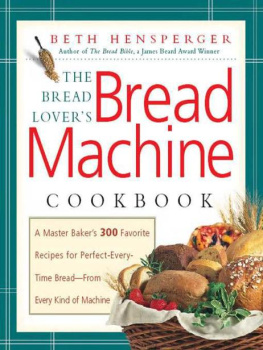Contents
Landmarks
B OOKS BY J AMES B EARD
Hors dOeuvre and Canaps
Cook It Outdoors
Fowl and Game Cookery
The Fireside Cookbook
Paris Cuisine (with Alexander Watt)
Jim Beards New Barbecue Cookbook
James Beards New Fish Cookery
The Complete Book of Outdoor Cookery (with Helen Evans Brown)
How to Eat Better for Less Money (with Sam Aaron)
The James Beard Cookbook
James Beards Treasury of Outdoor Cooking
Delights and Prejudices
Menus for Entertaining
How to Eat (and Drink) Your Way Through a French (or Italian) Menu
James Beards American Cookery
Beard on Food
Theory & Practice of Good Cooking
The New James Beard
Beard on Pasta
James Beard
James Beard was born in Portland, Oregon, in 1903, and it was there that his palate was educated at an early age. His first cookbook, Hors dOeuvre and Canaps, was published in 1930. After that he wrote nineteen other books on food, including The fames Beard Cookbook, for years a best-selling paperback; the much-honored fames Beards American Cookery; and the companion volumes Theory & Practice of Good Cooking, which explored all the whys and wherefores of cooking as he taught his students, and The New James Beard, which put into practice what he preached. However, it is his highly popular Beard on Bread that has been his best-selling book of all time.
Beard started giving cooking lessons in the late 1950s, in what later became the kitchen of the famous restaurant Lutce. This was the beginning of his popular cooking school, later located in his own brownstone in Greenwich Village, which now houses the James Beard Foundation. Well known throughout the country, James Beard traveled extensively and taught and demonstrated cooking nationwide. He died in New York in 1985.
Basic Home-Style Bread
To most people homemade bread means a slightly sweet loaf made with milk and some shortening, quite light and rather fine in texture and much enjoyed when fresh with a generous spreading of butter and preserves. It is also popular for sandwiches and toast. Here is such a loaf, which I call home-style to distinguish it from my other basic white bread.
[2 loaves]
1 package active dry yeast
2 cups warm milk (100 to 115, approximately)
2 tablespoons granulated sugar
cup melted butter
1 tablespoon salt
5 to 6 cups all-purpose flour
1 egg white, lightly beaten (optional)
Add the yeast to cup of the warm milk, along with the 2 tablespoons sugar, and stir well until the yeast is completely dissolved. Allow the yeast to proof. Place the remaining milk, the melted butter, and the salt in a bowl. Stir in the flour, 1 cup at a time, with a wooden spoon. After the third cup, add the yeast mixture. Continue stirring in flour until the mixture is rather firm, which should take about 4 to 5 cups. Remove the dough to a floured board or a marble slab, and knead, adding more flour as necessary if it gets sticky, until it is supple, satiny, and no longer sticky. Butter a bowl and place the dough in it, turning to coat all sides with the fat. Cover and allow to rise in a warm, draft-free spot until doubled in bulk, about 1 to 2 hours.
Deflate the dough by punching it firmly two or three times, return to the floured board, and knead 4 to 5 minutes more. Divide into two equal parts and shape into loaves. Place in well-buttered 9 5 3-inch loaf tins, cover, and let rise again until doubled in bulk. Slash the loaves with a sharp knife and brush with lightly beaten egg white or water. Bake in a 400 oven for 40 to 45 minutes or until the bread sounds hollow when tapped with the knuckles. Remove the loaves from the pans and put them in oven a few minutes longer to become crisped.
French-Style Bread
French bread, as we all know, has been praised and prized above all other breads in the world for its distinctive crumb, crisp crust, and superb flavor. However, the carefully controlled preparation of it in commercial bakeries is difficult to duplicate in ones own kitchen. If you are ready for the challenge, you should search out a recipe that is as complete as the one developed by Julia Child and Simone Beck for Volume 2 of Mastering the Art of French Cooking. Their method seems tremendously complex but it is great fun to follow through to the final goal (and once mastered, not difficult to do again); the loaves are startlingly good and genuinely French.
The bread I am giving here is not truly French, and for that reason it is called French-style. Actually it could be called Continental, because it is very much like the bread one finds in Italy, Spain, and Portugal. It has also been known for many years as Cuban bread. It is a casual, easy-to-make bread that can be played with in several ways. If made according to the basic recipe below it produces a good loaf ready for eating almost the minute it comes from the oven. It will not hold for more than half a day but, of course, can be frozen.
[2 long loaves]
1 packages active dry yeast
1 tablespoon granulated sugar
2 cups warm water (100 to 115, approximately)
1 tablespoon salt
5 to 6 cups all-purpose or hard-wheat flour
3 tablespoons yellow cornmeal
1 tablespoon egg white, mixed with 1 tablespoon cold water
Combine the yeast with sugar and warm water in a large bowl and allow to proof. Mix the salt with the flour and add to the yeast mixture, a cup at a time, until you have a stiff dough. Remove to a lightly floured board and knead until no longer sticky, about 10 minutes, adding flour as necessary. Place in a buttered bowl and turn to coat the surface with butter. Cover and let rise in a warm place until doubled in bulk, 1 to 2 hours.
Punch down the dough. Turn out on a floured board and shape into two long, French bread-style loaves. Place on a baking sheet that has been sprinkled with the cornmeal but not buttered. Slash the tops of the loaves diagonally in two or three places, and brush with the egg wash. Place in a cold oven, set the temperature at 400, and bake 35 minutes, or until well browned and hollow sounding when the tops are rapped.
VARIATIONS
For a wheaten loaf, use half white flour and half whole-wheat flour.
Substitute equal parts of whole-wheat flour and cracked wheat for half of the white flour.
For a more involved, more tightly textured loaf: Use either the original recipe or the whole-wheat variation. After the first rising, remove from the bowl, punch down, and knead again for 5 to 10 minutes. Return to the buttered bowl for a second rising. When it has doubled in bulk, form into two loaves and place on a baking sheet sprinkled with cornmeal. Cover and let rise for 30 minutes. Slash with a sharp razor or knife, brush with slightly beaten egg white or water, and place in a cold oven set for 375 or 400. Bake until nicely browned and hollow sounding when tapped with the knuckles.
Line the oven rack with tiles, preheat the oven to 400, and slide your bread loaves from the baking sheet directly onto the tiles, which have been sprinkled with cornmeal.
Add to the liquid in the first step 4 to 5 tablespoons olive oil and then proceed with either the original recipe or the whole-wheat variation. You may need to use a small additional amount of flour.
Use white flour, whole-wheat, and cracked-wheat. This will give a very nice coarse, nutlike texture to the bread. With this mixture I would advise adding olive oil in the beginning to give tenderness.
Refrigerator Potato Bread
The potato and butter in this loaf give it a distinctive, very pleasant flavor. Moist and rather heavy in texture, it keeps extremely well in the refrigerator if stored in a plastic bag. It is nice for sandwiches or toast or as a breakfast or tea bread, and is reminiscent of breads that used to be common in the nineteenth century.












